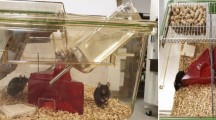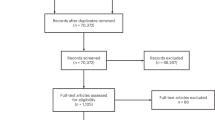Abstract
Timed matings of mice are often carried out to obtain offspring of a precise age when required for a study. Timed matings involve housing male and female mice together for a limited time period, typically overnight. A limitation of this practice is that many mouse pairs fail to mate during the brief co-housing period. The authors co-housed each breeding pair in the same cage but separated by a transparent partition for 3 d before carrying out timed matings. This co-housing strategy resulted in increased copulation during the timed mating period and also significantly increased the average number of pups produced per breeding pair. The authors suggest that co-housing likely permits male urine-borne pheromones to induce female estrus and also enables the expression of male and female mating behaviors.
This is a preview of subscription content, access via your institution
Access options
Subscribe to this journal
We are sorry, but there is no personal subscription option available for your country.
Buy this article
- Purchase on Springer Link
- Instant access to full article PDF
Prices may be subject to local taxes which are calculated during checkout




Similar content being viewed by others
References
Dackor, R.T. et al. Hydrops fetalis, cardiovascular defects, and embryonic lethality in mice lacking the calcitonin receptor-like receptor gene. Mol. Cell Biol. 26, 2511–2518 (2006).
Anderson, G. & Jenkinson, E.J. Fetal thymus organ culture. Cold Spring Harb. Protoc. published online, doi:10.1101/pdb.prot4808 (1 August 2007).
Whitten, W.K. Modification of the oestrous cycle of the mouse by external stimuli associated with the male. J. Endocrinol. 13, 399–404 (1956).
Jemiolo, B., Harvey, S. & Novotny, M. Promotion of the Whitten effect in female mice by synthetic analogs of male urinary constituents. Proc. Natl. Acad. Sci. USA 83, 4576–4579 (1986).
Ma, W., Miao, Z. & Novotny, M.V. Induction of estrus in grouped female mice (Mus domesticus) by synthetic analogues of preputial gland constituents. Chem. Senses 24, 289–293 (1999).
McClintock, M.K. in Hormones, Brain, and Behavior 1st edn. (eds. Pfaff, D.W., Arnold, A.P., Etgen, A.M., Fahrbach, S.E. & Rubin, R.T.) 797–870 (Academic, San Diego, CA, 2002).
Novotny, M.V., Ma, W., Wiesler, D. & Zidek, L. Positive identification of the puberty-accelerating pheromone of the house mouse: the volatile ligands associating with the major urinary protein. Proc. Biol. Sci. 266, 2017–2022 (1999).
Keller, M., Pierman, S., Douhard, Q., Baum, M.J. & Bakker, J. The vomeronasal organ is required for the expression of lordosis behaviour, but not sex discrimination in female mice. Eur. J. Neurosci. 23, 521–530 (2006).
Kudryavtseva, N.N. Use of the “partition” test in behavioral and pharmacological experiments. Neurosci. Behav. Physiol. 33, 461–471 (2003).
Kelliher, K.R. The combined role of the main olfactory and vomeronasal systems in social communication in mammals. Horm. Behav. 52, 561–570 (2007).
Roullet, F.I., Wöhr, M. & Crawley, J.N. Female urine-induced male mice ultrasonic vocalizations, but not scent-marking, is modulated by social experience. Behav. Brain Res. 216, 19–28 (2011).
Institute for Laboratory Animal Research. Guide for the Care and Use of Laboratory Animals 8th edn. (National Academies Press, Washington, DC, 2011).
Van Loo, P.L., Van de Weerd, H.A., Van Zutphen, L.F. & Baumans, V. Preference for social contact versus environmental enrichment in male laboratory mice. Lab. Anim. 38, 178–188 (2004).
Silverman, J.L., Yang, M., Lord, C. & Crawley, J.N. Behavioural phenotyping assays for mouse models of autism. Nat. Rev. Neurosci. 11, 490–502 (2010).
Acknowledgements
We thank Michael T. Klennery in Mayo Clinic's Biomechanical Shop for designing and fabricating the transparent cage partitions and Laurie R. Severson for overseeing the testing data for sentinel mice. This work was funded by Mayo Foundation (A.G.S. and D.G.) and by a grant from National Institutes of Health (D.G.).
Author information
Authors and Affiliations
Corresponding author
Ethics declarations
Competing interests
The authors declare no competing financial interests.
Rights and permissions
About this article
Cite this article
Stiles, R., Schrum, A. & Gil, D. A co-housing strategy to improve fecundity of mice in timed matings. Lab Anim 42, 62–65 (2013). https://doi.org/10.1038/laban.161
Received:
Accepted:
Published:
Issue Date:
DOI: https://doi.org/10.1038/laban.161



